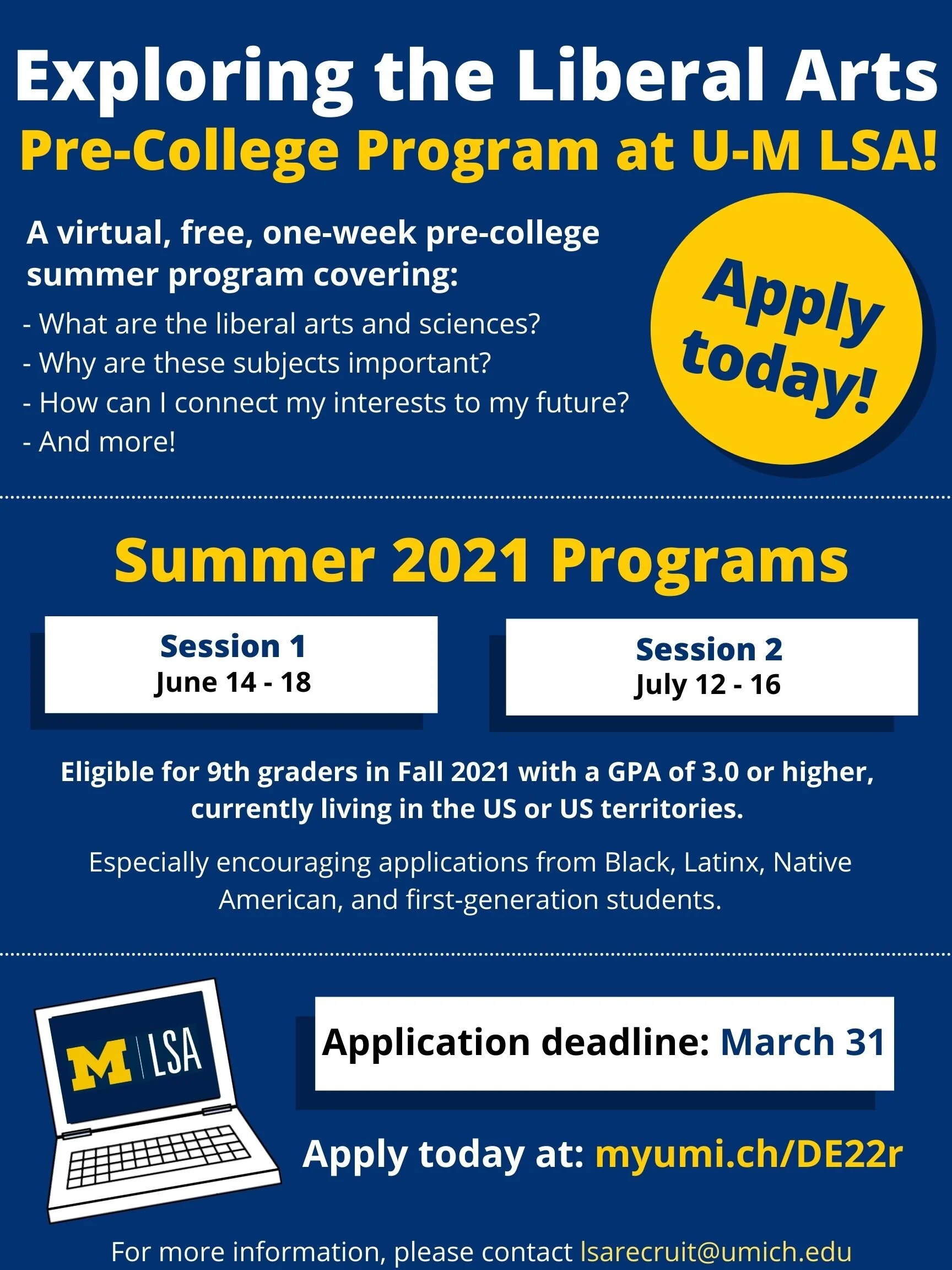LSA Recruitment.
The College of Literature, Science and the Arts is the oldest and largest school at the University of Michigan, dating back to its establishment in 1841. Today, it holds more students than other other department. It is home to some of the most popular majors, including Economics, Psychology, Computer Science, Foreign Language and many more, totaling in 85 majors and 100 minors. Because of its breadth of study, LSA recruits and accepts the largest amount of students from the incoming class, resulting in half of the undergraduate population. The recruiting for this college is therefore extremely important, completed through campus tours, high school outreach, one-on-one meetings, current student experiences, and digital outreach.
-
Involvement.
Recruitment Assistant & Graphic Designer
January 2020 - May 2022
-
Projects.
Design logos for recruitment events, create graphics for social media publicity, and produce and edit videos.
-
Tools.
Procreate
Adobe Creative Cloud
Leadership.
As a recruitment assistant, I act as a representative of the university. Three times per week, I would co-present an hour long session with an LSA faculty member, highlighting college opportunities along with my own experience.
The attendance at these events ranged from 100 to 300. As a university employee, I had access to public speech coaches which whom I met regularly. I additionally completed diversity, equity and inclusion training to avoid micro-aggressions and be the most inclusive as possible.
Covid-19 & Digitalizing Recruitment.
Like most American colleges, the University of Michigan closed its gates in March 2020 as a result of the pandemic. Classes became virtual, clubs met through Zoom, and many students left Ann Arbor. As of March 1st, the largest wave of LSA students were admitted for the incoming class of 2024. Without an opportunity to see campus, attend a live class, and meet with current students, LSA recruitment had to quickly find online ways to reach this group. Below are the enacted solutions to digitalize the campus day experience.
Canvas Site
Canvas is a course management system that supports online learning and teaching. It allows professors to post grades, course announcements, and assignments online. Because of the university’s familiarity with this program, we felt it best to incorporate campus day modules into this service to display information and acclimate potential students to the university’s home base.
3. Campus Tour
I remember my campus tour being the largest push towards making my college decision. Like many others, I got “that feeling” that ultimately made me choose U of M. Travel restrictions and social distancing made in-person tours impossible. So I pushed to create a virtual experience to give students that same opportunity I’d had. The tour included main campus, dorm life, and campus buildings.
2. Student Videos
As mentioned, traditional campus days involve student speakers co-presenting with an LSA faculty member. Topics include: curriculum, breadth of course work, internships, professional development, study abroad, tutoring resources and student experience. In order to keep the digital campus day personal, student speakers would create videos of those same topics.
4. Personal Meeting Invitations
Although each recruitment push so far has laid out vital information for prospective students, it doesn’t offer room for questions and a personal experience. I did not want students to feel as though pre-recorded videos were their only way to connect with the school. Multiple times per week, sessions were hosted with current students, including myself, to ask any remaining questions and connect with students.
Graphics.
Below are a few of the graphics created using Photoshop, Procreate, InDesign and Canva, published on the College of LSA Instagram and sent through mass emails to admitted students.
Within the constraints of the university's brand, I was limited to a specific hex color for blue and maize. I was additionally required to find unique places for the university’s logo.
In terms of diversity, equity and inclusion, I decided to involve only graphics of people, not images. As seen in the “admitted students” poster, the woman is seen with red-orange skin. After much research, I have found this human—style graphic to be the most inclusive because it does not directly pertain to any specific race. With approval from the marketing team, I decided to pursue this design.
Next steps.
Through the light at the end of the Covid-tunnel is in sight, I intend for these resources to live long past 2021. The created graphics, videos, Zoom meetings, and Canvas page acts as a virtual experience to those who are not able to attend the in-person Campus Day sessions. With constraints of travel finances, time off, disability, and academic commitments, I hope for these resources to reach many more admitted students and continue to market the university.


